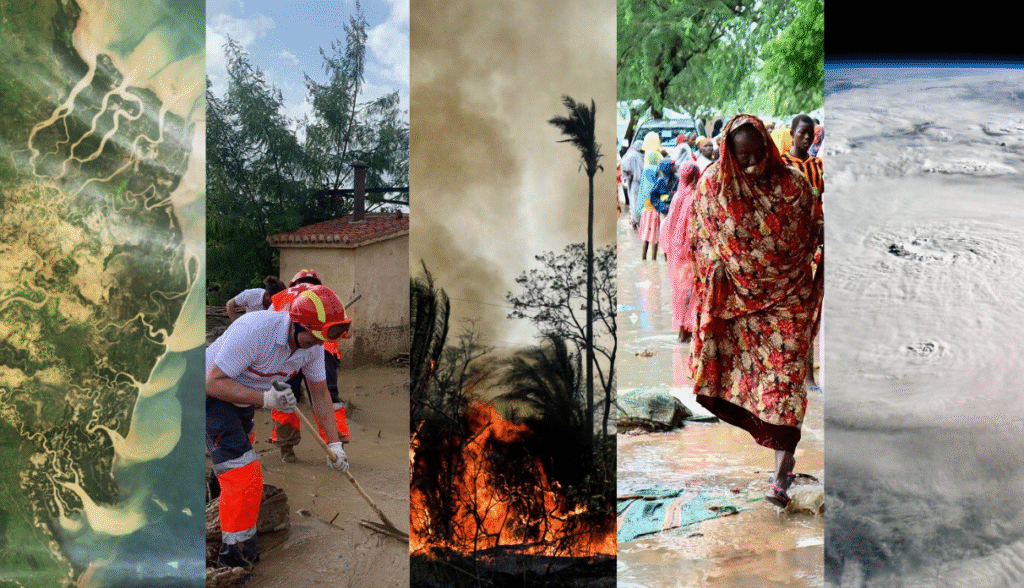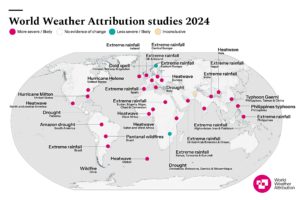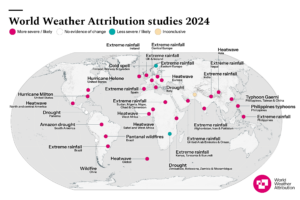When Risks Become Reality: Extreme Weather in 2024 is our annual report, published this year for the first time. Every December, people ask us how severe the year’s extreme weather events were. To answer this question, we’ve partnered with Climate Central. To produce a report that reviews some of the most significant events and highlights findings from our attribution studies.
It also includes new analysis looking at the number of dangerous heat days added by climate change in 2024. And global resolutions for 2025 to work toward a safer, more sustainable world.

When Risks Become Reality
Key messages
- Extreme weather reached dangerous new heights in 2024. This year’s record-breaking temperatures fueled relentless heatwaves, droughts, wildfires, storms, and floods. These events killed thousands of people and forced millions from their homes. This exceptional year of extremes shows how dangerous life has already become with 1.3°C of human-induced warming. It highlights the urgent need to move away from planet-heating fossil fuels as quickly as possible.
- Climate change caused at least 3,700 deaths in 2024. Millions were displaced in 26 weather events we studied. These 26 events are only a small part of 219 major events we tracked. The total deaths from extreme weather made worse by climate change this year are likely in the tens or hundreds of thousands.
- Globally, climate change added an average of 41 extra days of dangerous heat in 2024, threatening people’s health. This is according to new analysis by Climate Central. The countries with the highest number of dangerous heat days are mostly small island and developing states. These nations are highly vulnerable and on the frontlines of climate change. The analysis highlights the wide reaching impacts of extreme heat that are underreported and not well understood.
When Risks Become Reality: Extreme Weather in 2024
Many extreme events at the start of 2024 were influenced by El Niño. However, most of our studies found that climate change played a larger role than El Niño in driving these events. This includes the historic drought in the Amazon. As the planet warms, climate change increasingly dominates other natural weather influences.
Record-Breaking Temperatures and Floods
Global temperatures in 2024 reached record highs, leading to record-breaking downpours worldwide. From Kathmandu to Dubai, Rio Grande do Sul, and the Southern Appalachians, the past 12 months saw many devastating floods. We studied 16 floods and found that climate change amplified rainfall in 15 of them. This aligns with basic climate physics: a warmer atmosphere holds more moisture, causing heavier rain. Failures in early warning systems and evacuation plans likely contributed to high death tolls. Floods in Sudan and Brazil underscored the urgent need to maintain and improve flood defenses.
Impact on Ecosystems and Storms
Climate change severely affected the Amazon rainforest and Pantanal Wetland in 2024. Intense droughts and wildfires caused massive biodiversity loss. The Amazon is the world’s largest land-based carbon sink and is crucial for stabilizing global climate. Ending deforestation will help protect these ecosystems from drought and wildfire, as dense vegetation absorbs and retains moisture.
Warmer seas and air fueled more destructive storms, including Hurricane Helene and Typhoon Gaemi. Attribution studies show these storms have stronger winds and produce more rain. Climate Central found that climate change increased the intensity of most Atlantic hurricanes between 2019 and 2023. Of 38 hurricanes analysed, 30 had wind speeds one category higher on the Saffir-Simpson scale than they would have without human-caused warming. Our analysis also found the risk of multiple Category 3-5 typhoons hitting the Philippines in a single year is rising as the climate warms.

Resolutions for 2025
A faster shift away from fossil fuels is crucial. Burning oil, gas, and coal drives global warming and worsens extreme weather. At COP28 last year, countries agreed to move away from fossil fuels. Yet new oil and gas fields continue to open worldwide. This risks pushing warming beyond 1.5°C, with severe costs for people everywhere. Every fraction of a degree makes weather extremes worse. Switching quickly to renewable energy will help create a safer, healthier, and more stable world.
Improving Early Warning Systems
The extreme weather in 2024 showed how vital early warning systems are. They are among the cheapest and most effective ways to save lives. Warnings must be issued days before dangerous events and provide clear, actionable instructions. Most extreme weather is forecastable, even in developing countries. Every nation needs to build, test, and improve these systems to keep people safe.
Real-Time Reporting of Heat Deaths
Heatwaves cause more deaths than any other extreme weather. Yet the risks of high temperatures often go unnoticed and unreported. In April, a hospital in Mali reported a surge in deaths as temperatures neared 50°C. Local media covered this rare real-time warning from health professionals. Since health systems are often overwhelmed, informing local journalists about spikes in emergency cases can raise public awareness that extreme heat is deadly.
Financial Support for Developing Countries
At COP29, discussions focused on increasing funding to help poorer nations cope with extreme weather impacts. Developing countries have contributed little to historic emissions but suffer the worst consequences. Repeated disasters like typhoons in the Philippines and floods after droughts in East Africa erase development gains. These countries must have the resources to invest in adaptation. Doing so will save lives, protect livelihoods, and promote a fairer, more stable world.

